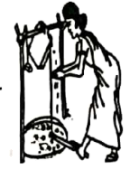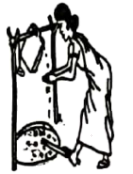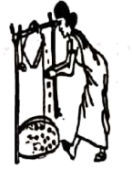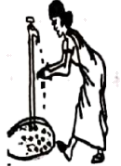1 . “Be proud of what you do,” my father always told me, “whether you are a boss or a cleaner.” When I was 15, I got a summer job in a hospital. I was told that my duties would include sweeping floors. I smiled and remembered Dad's words. Even though my job was the lowest, it made me feel excited. I saw it as a challenge because it was my first job. I learned to be on time and tried to do everything well. In return, I was treated with respect by doctors, nurses and patients. Each morning I imagined that the dirty dishes would make patients more sick if I were not there to wash them clean. After breakfast was done, I started sweeping the floors of all patient rooms and cleaning the toilets. Though I was tired, I wanted the job to be done well. Hearing people say “That young boy really does a good job”, I was filled with pride.
Working in the hospital taught me that being proud of one's job is important. It does not matter whether the job is sweeping floors or managing a large business. Through every job I have ever had, my father's words have always stayed with me. I was a good cleaner, and now I'm a good manager. I think Dad would be proud of me all the time.
1. The writer's first job was a ________.| A.boss | B.manager |
| C.cleaner | D.doctor |
| A.Washing dishes. | B.Looking after patients. |
| C.Cleaning toilets. | D.Sweeping the floor. |
| A.worked hard | B.wasn't tired |
| C.made the patients sick | D.did everything |
| A.the writer's father always stayed with him |
| B.the father didn't like the writer's first job |
| C.the writer wasn't proud of his first job |
| D.the father's words encouraged the writer to do everything well |
2 . When I was 12 years old, I already knew that my teen years were going to be the worst years of my life. I was a total outsider, bullied (欺凌)at school. I felt completely alone in my small town.
But by starting to do volunteer work when I was 14, I turned my problem into a passion for helping others. The opportunity to practice kindness made me feel like my life had a greater purpose. The more positive energy 1 shared, the more kindness and appreciation I received, I realized that my purpose in life would be to reach out to people, specifically teenagers, and help them feel less alone.
Books were my true friends back then. I was so thankful that the authors wrote those books. The kindness they offered me with their books saved my life. One of my biggest dreams was to become an author so I could write books that would help other teenagers the way those books helped me.
After surviving the terrible experiences at school and at home, 1 made a choice to take the optimistic, positive road in the next steps of my journey. My dream career, one I thought was only possible for the authors I loved, is what I am doing now. I have been a full-time author of teen novels since 2007 and am grateful for this amazing opportunity to reach out to readers every single day.
Kindness saved me when I needed help the most. Even small acts of kindness can change someone's life. You never know what someone else is going through. But by practicing daily kindness, you become an architect of positive change.
1. What was the author's life like when he was 12?| A.Boring. | B.Peaceful. | C.Joyful. | D.Unhappy. |
| A.It helped him find the goal of life. |
| B.It made him energetic in his life. |
| C.It helped to shape his dream career. |
| D.It helped him understand others' lives better. |
| A.he was inspired by his teacher. |
| B.he found he had a talent for writing. |
| C.he could pass positive energy to readers. |
| D.he wanted to share his teenage experiences. |
| A.Say 'no' to bullies bravely. |
| B.Make positive changes in our lives. |
| C.Treat others with kindness in daily life. |
| D.Learn to care more about others' feelings. |
3 . When it comes to sitting properly, we all know the correct way even if we don' t do it to the letter. No crossed legs, bottoms touching the back of the chair and feet on the ground. But even if you' re doing it right, sitting for long periods is shockingly bad for you. It has been described as the new smoking, linked to heart disease and even cancer. There is no doubt we should all try to do less of it. But perhaps we could also do it better.
A classic survey, published in 1953, described 100 different sitting postures adopted by 480 cultures around the world. Among the most common were sitting cross-legged, kneeling and the deep squat (深蹲), with feet flat on the ground and bottoms resting on or just above it. Even in Western cultures, these are preferred sitting positions among young children. But Westerners tend to prefer chair use from an early age, insisting children sit on seats in school.
One big problem with this desire for chairs is that they make sitting so, well, sedentary (久坐不动的). Consider the Hadza, a group of hunter-gatherer people in Tanzania. They spend around 9 hours a day sitting. However, they squat and sit on the ground in various positions, and this involves high levels of muscle activity. The supportive nature of chairs, with their high backs and armrests, removes this effort perhaps the reason that people love them.
So what' s the best way to sit? Josette Bettany-SaItikov at Teesside University, UK has found that kneeling can help keep the spine in a better position as does squatting. We might also take inspiration from traditional cultures like the Hadza. "Use a variety of postures and preferably not just still postures but some which allow movement," says Bettany-Saltikov.
Bettany-Saltikov believes that we should be rethinking what it means to do a desk job. "We still need to design workplaces that enable people to be productive while being lightly active, like with under-table cycling or walking desks," she says. For now, if your job is sedentary, don' t forget to stand up regularly and move around.
1. What does the author think of sitting properly for long?| A.It still does some harm. | B.It improves body shape. |
| C.It can prevent heart disease. | D.It may cause smoking-related illnesses. |
| A.Children should sit in their preferred manner. |
| B.Children should take their seats while sitting. |
| C.Children should practice sitting cross-legged. |
| D.Children should learn different sitting postures. |
| A.They sit for short periods of time. | B.They sit for the purpose of exercise. |
| C.They use some muscles while sitting. | D.They remain generally still while sitting. |
| A.Combine exercise and their work. | B.Improve their productivity at work. |
| C.Kneel or go cycling as often as possible. | D.Start exercising as soon as they leave work. |
4 . Angkor Temples Jungle Bike Route
You'll be picked up from your hotel at 8 am. Given everything you need for your tour, you'll begin cycling in the direction of Angkor, the former capital of the Khmer Empire.
The first stop on your route will be la Prohm. The carved stone walls of this designated World Heritage Site are just about visible between the overgrown roots and branches of the surrounding forest. This mythical temple was chosen as a scene for the filming of Tomb Raider.
Your route will then continue towards the lost city of Angkor Thom. From here, you'll head to Prasat Bayon, known for its famous face towers.
Visit the Terrace of Elephants, the over 1,000-foot-long viewing platform, and the Terrace of the Leper King.
You'll take a break at a local restaurant, where you'll enjoy a lunch of tasty traditional Cambodian dishes. After lunch, you'll begin your route back to Siem Reap.
Duration : 5-8 hours.
Included :
• English-speaking guide.
• Bike and helmet.
• Bottled water.
• First aid kit.
• Lunch.
Not included: Snacks and fruit.
How to book?
To reserve the activity, choose the date and complete the form on the website. You will receive your confirmation immediately.
If you still have more questions, check out our Q&A section on frequently asked questions. If you need help to book an activity or have any enquiries, please contact us.
Free cancellation
Free! Free cancellation up to 48 hours before the activity starts. If you cancel within this time or do not show up, you will not be refunded.
1. Which scenic spot appeared in the movie Tomb Raider?| A.Ta Prohm. | B.Angkor Thom. |
| C.Prasat Bayon. | D.The Terrace of Elephants. |
| A.Helmet. | B.Lunch. | C.Water. | D.Fruit. |
| A.By emailing the agency. |
| B.By filling out a form online. |
| C.By checking out the Q&A section. |
| D.By showing up at the agency two days in advance. |
5 . When you are having dinner, do you eat up all the food on your plate or have some leftover(剩菜剩饭)? According to the UN, 1. 3 billion tons of food is wasted around the world every year. That’s about one - third of all food produced each year.
We make a survey in 34 countries to see how much food is wasted in different countries. For example, the UAE(阿联酋) wastes the most food, with each person wasting about 1, 000 kilos every year on average. However, some countries have worked hard to use their food resources wisely. France wastes the least amount of food, according to the survey.
France was the first country to pass laws that stop food waste. It’s not allowed to throw away fresh food. Another law forces French restaurants to provide bags for people’s leftovers.
China ranked 23rd for food waste in the survey. China’s food waste is around 18 million tons every year, enough to feed up to 50 million people for one year. Facing this situation, China has been working hard to reduce food waste. Since early 2013, a movement to prevent food waste called “empty plate” has begun. It has become popular among both government officials and general public.
1. How much food is produced every year around the world?| A.1, 000 kilograms. | B.More than 34, 000 kilograms. |
| C.About 1. 3 billion tons. | D.Nearly 4 billion tons. |
| A.China. | B.France. | C.The United States. | D.The UAE. |
| A.started a movement called “empty plate” |
| B.passed laws to ban food waste |
| C.buys more food from other countries |
| D.produces less food each year |
| A.UAE wastes the most food. |
| B.China has been working hard to reduce food waste. |
| C.You can throw away fresh food in France. |
| D.1.3 billion tons of food is wasted around the world every year. |
6 . It’s Earth’s birthday! The Earth is about 4.5 billion years old! In honour of our planet, former U. S. Senator Gaylord Nelson decided we needed a special day to celebrate and learn how to care for our environment. He wrote letters to many schools about the day he planned because he knew kids like you would help.
On April 22, 1970, the first Earth Day was held. Many environmental laws were passed, and people all over the country made promises to protect the environment.
Since then, Earth Day has spread around the world and people are working together to create cleaner air and energy to take care of Mother Nature. Learn how you, your family and friends can start making a difference too!
Earth Day is now celebrated by hundreds of millions of people in more than 180 countries. Here are some ways that you can help re-energize the Earth and celebrate too!
·Visit a nature conservancy(保护协会). Nature conservancies teach us how to preserve our natural history.
·Have an Earth Day block party! Invite neighbourhood kids to plant gardens or trees or pick up trash. Then celebrate your achievements with some Earth Day’ treats and nature music.
·Challenge your family to “go green”. Walk, bicycle, carpool or take the bus to reduce greenhouse gases and get outdoors!
·Wear green, a nature or Earth Day T-shirt to help spread the word about caring for our environment.
·Make a “planet promise” to reduce your energy use and recycle.
We hope you’ll use some of these ideas during the week of April 22 to celebrate and give back to the Earth that gives so much to us.
1. Why did the former U. S. Senator Gaylord Nelson write letters to many schools?| A.To show his care about the planet. |
| B.To have a good relationship with them. |
| C.To encourage their students to work hard. |
| D.To expect their students to protect the environment. |
| A.Forty five. | B.Forty nine. | C.Fifty one. | D.Fifty six. |
| A.An Earth Day block party. | B.A nature conservancy. |
| C.Your family and friends. | D.A “planet promise”. |
| A.The way for the Earth Day to appear. |
| B.The first person to create the Earth Day. |
| C.The origin and celebrations of the Earth Day. |
| D.Reasons for people to celebrate the Earth Day. |
7 . Handwashing is one of the easiest ways to protect against disease, but lack of running water is a problem for 3 billion people in the world, according to the World Health Organization(WHO) and UNICEF, the United Nations Children's Fund. Tippy taps are one way. Sometimes, the little things make such a big difference. These low-cost handwashing stations are helping people stay healthy.
There are different ways to build and use tippy taps. But the basic tools include a plastic water bottle, sticks, and rope. Hang the bottle from a branch or pole. Press a foot pedal to tip the bottle and release water. Then wet your hands and scrub with soap for at least 20 seconds. Done!
In Uganda, Faridah Luanda has been teaching her neighbors how to make tippy laps. Washing hands is very difficult in her neighborhood because they don't have access to washing facilities. When COVID-19 started and people were told to clean their hands frequently, they needed to be creative. Luanda and her neighbors have set up 800 tippy taps in the community. “We are helping ourselves,” Luanda says “Children, people with disabilities, and other vulnerable people—they cannot be left behind.”
In Guatemala, people have set up nearly 400 tippy laps. Each cost about $12 to make.
Tippy taps are also being used in the United States. Kids from the Lake & Park School, in Seattle Washington, heard about the project. They raised $4,000 to support it. In Tucson, Arizona, they' re helping the homeless. Two were set up at a shelter called Sister Jose Women’s Center. COVID-19 forced the shelter to close. But workers continued to give out food. They needed a way to let people wash their hands before eating. The tippy tap is such a simple solution.
1. What does the author think of tippy taps?| A.They are invented by the WHO | B.They can ease the water shortage. |
| C.They are money-saving and effective. | D.They are too expensive to popularize. |
A. | B. | C. | D. |
| A.Lazy. | B.Weak | C.Dirty. | D.Foolish. |
| A.The homeless. | B.The school children. |
| C.The volunteer workers. | D.The patients in hospital. |
8 . Years ago, my wife and I volunteered at a homeless shelter in downtown Los Angeles, US, preparing meals for thousands of people. I got to talk with one of them in line, Albert. He said he liked my socks. “Want to see mine?” he asked, lifting his leg. He was barefoot (赤脚的). He said he had been meaning to buy a pair but he hadn’t got around to it. I felt a sinking feeling in my stomach.
The next day, after work I stopped at Ross and filled up my car with socks. That next morning, I drove over to Santa Monica’s Palisades Park, which is a common place for homeless people. I knew that when they woke up they would find a very meaningful present.
That was nine years ago. Every week I’ll hand out as many socks as I can. If I’m on vacation or on a business trip for more than a week, I bring a bag of socks with me and hand them out to the homeless on the streets in other states and countries.
It’s extremely satisfying to do “under the radar” things to help make some people’s lives a little bit easier. Part of me hopes to see Albert out there one of these days, but even if I don’t, I’d like to think one of the pairs will find him.
1. What caused the author to hand out socks to the homeless?| A.A homeless shelter’s request. |
| B.His wife’s volunteer work. |
| C.His talk with Albert. |
| D.A festival’s arrival. |
| A.He wondered about the reason behind it. |
| B.He expected to get more socks. |
| C.He refused to accept it. |
| D.He was afraid of it. |
| A.Spreading presents on trips |
| B.Looking for Albert all over the world |
| C.Giving the homeless a lifetime surprise |
| D.Helping the homeless in an unexpected way |
9 . I took one of the bags from my car. It was still dark out. I headed for a group of three men, standing around a tree, probably using it as a windbreaker. As I walked toward them, one of them watched me, perhaps questioning my motives. “I thought you all might need some fresh new socks,” I said, handing him a pair. He looked confused at first but took them and said, “Thank you.” I gave him two more pairs for his friends. I moved on. An hour later, I had given out all the socks. Most people were sleeping, and I felt like Santa. On her first day teaching students from poor families at an after-school program in New York City, Alyssa Kapasi noticed how many kids were lining up for free sandwiches and fruit in the school cafeteria. One of the workers explained that many of these students don’t get enough to eat at home, so a school lunch or an after-school meal might be the most food they would get all day.
Kapasi, who attends private school, was very surprised. What’s more, she made up her mind to help. “I want other kids to understand that if you see a problem, you don’t have to wait to grow up to fix it,” says Kapasi. She and a group of friends are now putting their programming skills to work to create an app called Food for Thought, which will allow parents, students, and even kind-hearted strangers to donate to a lunch account for a student in need at a nearby school.
About 20 million American kids receive free lunches. Two million more can have low-price meals, and those students’ families have to pay for part of their food. When they don’t have the money on any given day, the students might have to settle for an “alternative (可替代的) meal” such as a cheese sandwich.
The app — which is getting financial (财政的) support from a GoFundMe page — provides anonymity (匿名) to those who receive lunch and donors. To receive help, a family will need only a recommendation (推荐) from a school teacher, and no one else has to know.
“I want to make an app that all users feel no shame in using,” says Kapasi. She hopes to test the app in a school district this fall.
1. Why does Kapasi want to create an app?| A.To teach kids how to help others. | B.To practise her programming skills. |
| C.To introduce her school to the public. | D.To solve the problem of hunger in schools. |
| A.Buy. | B.Make. | C.Accept. | D.Offer. |
| A.Visit a GoFundMe page. | B.Get in touch with Kapasi. |
| C.Be recommended by teachers. | D.Donate something else instead. |
| A.They won’t lose face in using it. | B.They will make money by using it. |
| C.They will know who offers them help. | D.They won’t meet their donors until this |
10 . Every day, we have messages to give people through Post-it Notes. They have a special glue on the edge(边缘)of the paper. They are sticky so that you can leave them anywhere and they won’t fall off. You can reuse the notes because the special glue on the back doesn’t wear off easily.
Who invented Post-it Notes? Art Fry was a scientist who worked for the famous 3M Company. He needed a bookmark that stayed in place but didn’t tear(撕)the page when he wanted to remove it. So he took some of the weak glue a friend made and put it on the back of a yellow piece of paper. Then he wrote a report to his boss and put the yellow sticky paper on the top page. His boss took off the note, wrote an answer, stuck the paper back on, and sent it back. This was the beginning of Post-it Notes. It was a new and creative way to communicate.
Today, Post-it Notes are one of the most popular office products. Everyone uses them for many different purposes. One man used one to write a marriage proposal(求婚)and put it on his girlfriend’s front door. She wrote her answer and put the note back on his door. One mother put a note on the back of her son’s car before he left on a long trip. When he arrived, he found the note. After 3,000 miles, it was still on the car. One university student was waiting in the bus station and started to feel sleepy. She didn’t want to miss her bus so she put Post-it Notes all over herself. The notes asked people to wake her up in time for her bus. She did fall asleep but her plan worked. Someone saw the notes and woke her up.
There are Post-it Notes to please everyone’s tastes. You can buy Post-it Notes in fifty different colors, twenty-seven different sizes, and fifty-six different shapes. More than 400 Post-it products are sold in more than 100 countries around the world. Art Fry should be proud of his invention.
1. What do we know about Post-it Notes?| A.They use a strong glue to be sticky enough. | B.They are used to leave messages. |
| C.They are one-off products. | D.They fall off easily. |
| A.he was making some glue | B.he was discussing with his boss |
| C.he creatively glued a torn report | D.he accidentally created a bookmark |
| A.To ask someone to wake her up in time. |
| B.To prevent herself from falling asleep. |
| C.To find out what time the bus left. |
| D.To tell others to leave her alone. |
| A.They are popular in many places. |
| B.They require design improvement. |
| C.They have failed to meet everyone’s needs. |
| D.They would not satisfy Art Fry’s expectation. |



